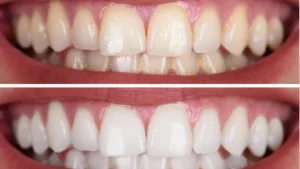Dentures, those removable teeth replacements, are like time-traveling devices for your smile. They take you from the “before” state, where missing teeth may cause discomfort and self-consciousness, to the “after” stage, where you can confidently share your smile with the world. Dentures before and after are vital because it’s about regaining comfort, chewing ability, and self-esteem. Think of it as upgrading your oral well-being.
We’ll walk you through this transformation, showing you how dentures change lives. So, if you’re curious about what happens “before and after” dentures, let’s dive in and explore the remarkable path to a brighter smile.
Before Getting Dentures
Assessing Your Oral Health
Determining if dentures are needed involves evaluating the state of your teeth and gums. Dentists examine any remaining teeth for health and stability. They also look for signs of gum disease or infections that could affect denture fitting.
Read Also:Dental Veneers Pros and Cons: Is it the Right Choice for You?
Consulting a Dentist
Schedule a visit to a dentist to discuss your oral health concerns. They’ll assess your current dental condition and discuss denture options tailored to your needs.

Dental Impressions and Measurements
During your dentist visit, impressions (molds) of your mouth will be taken. These impressions guide the creation of dentures that fit your mouth’s unique shape.
Exploring Denture Types
Your dentist will introduce you to different denture options. Complete dentures replace all teeth, while partial dentures are for a few missing teeth. Your dentist will recommend what suits you best.
Dentures Before and After: The Transformation Journey
Embarking on the denture journey marks a significant change in your oral health. You’re transitioning from the discomfort of missing teeth to the comfort and functionality of dentures.
Examining the Oral Health Prior to Dentures
Before getting dentures, your dentist assesses your remaining teeth and gums to ensure they are in the best possible condition. Any necessary treatments are addressed before denture fitting.
The Denture Fitting Process
Creating dentures involves taking precise impressions of your mouth, ensuring a snug fit. These impressions guide the construction of dentures that align well with your gums and remaining teeth.
Adjusting to New Dentures: Challenges and Tips
As you begin wearing dentures, you might experience challenges like slight discomfort or difficulty speaking.
Practice and patience are key to overcoming these challenges. Your dentist can provide guidance and tips to ease this transition.
Read Also: Dental Veneers for Gapped Teeth
Follow-up Appointments and Maintenance
After receiving your dentures, follow-up appointments are crucial. Dentists make necessary adjustments to ensure proper fit and comfort. You’ll also learn how to clean and care for your dentures for long-lasting use.
After Getting Dentures
Immediate Period After Denture Placement
Right after receiving your dentures, there might be an adjustment phase. It’s common to experience a sense of fullness and mild soreness as your mouth adapts to the new appliances.
Adapting to Speaking and Eating with Dentures
Speaking and eating might feel different initially. Practice speaking slowly and clearly to regain your natural speech. Start with soft foods, and gradually include harder items as you become more comfortable.

Maintaining Oral Hygiene with Dentures
Oral hygiene remains essential even with dentures. Remove and clean your dentures daily using a gentle brush and recommended cleansers. Ensure you also clean your gums and any remaining teeth to prevent oral issues.
Potential Discomforts and How to Manage Them
Minor discomforts like slight soreness or gum irritation are possible as you adjust to dentures. Rinsing with warm saltwater and applying a denture adhesive can offer relief. If discomfort persists, consult your dentist.
Read Also: How Long Does a Dental Cleaning Take?
Long-term Care and Denture Replacement
Over time, your mouth’s shape can change slightly. Regular dental visits ensure your dentures continue to fit well. However, dentures may need replacement after several years due to wear or changes in your oral structure.
Conclusion
In the journey of Dentures Before and After, we’ve explored the transformative process that takes you from missing teeth to a confident smile.
Understanding your oral health’s status prior to dentures, the fitting process, and the adjustments afterward are all crucial for a successful transition.
By assessing your oral health, consulting a dentist, and undergoing precise dental impressions, you set the stage for well-fitted dentures.
The initial adjustment phase involves adapting to speaking and eating, along with maintaining oral hygiene.
Remember that discomfort is common in the early stages, but your dentist can provide remedies. Regular dental visits are essential for long-term care and potential denture replacement.
If you’re considering dentures, be informed, and approach the journey with patience and positivity. Your oral health and quality of life can greatly benefit from this transformative experience.
Frequently Asked Questions (FAQs)
1. How long does it take to get used to dentures?
Denture adaptation varies, but most people adjust within a few weeks. Practice and patience are key during this phase.
2. Can I eat normally with dentures?
Yes, with time and practice. Start with soft foods and gradually progress to harder items as you become accustomed to chewing with dentures.
3. How often should I clean my dentures?
Clean your dentures daily to remove food particles and prevent plaque buildup. Use a denture brush and recommended cleansers.
4. Will dentures affect my speech?
Initially, speaking might be slightly affected. Practice speaking slowly, and your speech will improve as you get used to your dentures.
5. Are there any food restrictions with dentures?
While there aren’t strict restrictions, it’s best to avoid extremely hard or sticky foods that could damage your dentures.
6. Can I sleep with my dentures in?
It’s generally recommended to remove dentures while sleeping to give your gums a chance to rest.
7. How often should I visit my dentist after getting dentures?
Regular dental check-ups are important for monitoring your oral health and ensuring your dentures fit well.
8. Can dentures be repaired if they break?
Yes, in most cases, dentures can be repaired by a dentist. Avoid DIY fixes to prevent further damage.
9. How long do dentures typically last?
Dentures can last around 5 to 10 years or more with proper care. However, changes in your oral structure may require adjustments or replacements.
Medical References
- Smith, P. B., & Raja, M. R. (2017). Complete Denture Fabrication in Contemporary Dental Practice: A Review. The Open Dentistry Journal, 11, 580–586.
- Felton, D., Cooper, L., Duqum, I., Minsley, G., & Guckes, A. (2011). Evidence-based guidelines for the care and maintenance of complete dentures. Journal of Prosthodontics, 20(S1), S1-S12.
- Jepson, N. J., & Jepson, N. J. A. (2004). A comparison of the retention and stability of implant-retained overdentures and implant-retained fixed prostheses: A literature review. Journal of Prosthetic Dentistry, 92(6), 578-586.
- Miranda, G. A., Morgano, S. M., & Snapp, K. R. (2000). A comparison of stress distributions in maxillary central incisors restored with cast posts and cores, custom direct composite cores, and posts and cores. The International Journal of Prosthodontics, 13(4), 278-284.
- Thomason, J. M., Kelly, S. A. M., Bendkowski, A., & Ellis, J. S. (2012). Two implant-retained overdentures—a review of the literature supporting the McGill and York consensus statements. Journal of Dentistry, 40(1), 22-34.
- Awad, M. A., Lund, J. P., Dufresne, E., & Feine, J. S. (2000). Comparing the efficacy of mandibular implant-retained overdentures and conventional dentures among middle-aged edentulous patients: Satisfaction and functional assessment. The International Journal of Prosthodontics, 13(5), 409-416.



